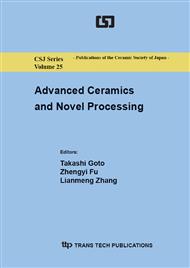p.134
p.141
p.145
p.153
p.157
p.166
p.174
p.178
p.183
Preparation and Electrical Property of Calcia Stabilized Zirconia Ceramics
Abstract:
In this paper, using ZrO2 and Ca (NO3)•4H2O as raw materials, we prepared a series of calica stabilized zirconia (CSZ) ceramics by pressureless sintering method. The results show that the relative densities of all sintered samples are above 90%, and the sintered samples are composed of cubic, tetragonal and monoclinic ZrO2, and the main phase is cubic ZrO2 and tetragonal ZrO2. The content of cubic phase increases with the increase of sintering temperature and adding CaO content. The grain size of the sintered samples is relatively uniform and some pores exist. Increasing the additive amount of CaO, the conductivity first rises and then decreases, and the conductivity value of the sample containing 5wt% CaO is the maximum. When the sintering temperature is up to 1600 oC, the conductivity of the sample containing 5wt% CaO is up to 0.016S•cm-1 at 800 oC. Furthermore, the conductivity of sintered samples is increasing with the increase of test temperature according to the Arrhenius equation.
Info:
Periodical:
Pages:
157-165
Citation:
Online since:
June 2014
Authors:
Keywords:
Price:
Сopyright:
© 2014 Trans Tech Publications Ltd. All Rights Reserved
Share:
Citation:


